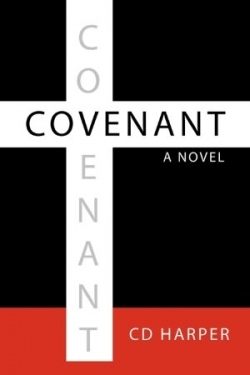Covenant
The Confederacy has fallen. The men and women of Covenant Plantation—both free and slave—must attempt to find out who they are in a new world of equality. As chaos pulls down the antebellum lifestyle, C. D. Harper begins the story of Sandy, a slave at Covenant and the master’s concubine. Sandy has taken her children, fathered by white plantation owner Seth Junior, and escaped with the other house slaves. Obsessed with her, Seth Junior sets out to bring her back.
The author uses imagery and phrases that go beyond mere scene setting: “It was past midnight when Seth Junior arrived back at the big house … he had searched for the hidden paths and trails on the plantation, realizing that hiding out for at least one night was the easiest thing for slaves to do.” This opening sets the tone for the internal and external hide-and-seek that fills the pages of Harper’s novel.
Rape, sexual encounters, and the comingling of bloodlines tie the characters together. Each searches heart and mind, as well as the Southern landscape, to discover his or her place in the new world order. Sandy strikes out for California without any concept of where it is or how to get there. Seth Junior struggles to keep the antebellum lifestyle alive, even though he doesn’t have the heart for it. Unlike his father, he doesn’t regard ownership of the land or of the plantation’s slaves as his right. Lulu, Seth Junior’s new wife, represents the white women’s enslavement and the paradigm shift from slavery to servitude.
Narrative perspective shifts between Crazy Bill, Sandy’s daughter Belle, and Seth Junior. Point of view also changes frequently. Readers hear the thoughts of old Hattie, who may remind movie buffs of Hattie McDaniel’s award-winning portrayal of Mammy in the film Gone with the Wind. Here, Hattie is Seth Senior’s concubine and Junior’s wet nurse.
Many characters in the novel border on the usual stereotypes. Yet, by emphasizing the perspective of the slaves, Harper deepens the typical master/slave dichotomy. The multi-layered writing is strong but uneven, and often reads more like a screenplay than a novel. Heavy on dialogue and light on exposition, one must sometimes search for clues to understand a scene. A good example involves Hattie. Readers learn of rat bites on her arms and legs before realizing she has probably had a stroke and is unable to move. Although black and white characters freely use the term nigger, it is used in the manner of the time period.
Readers who enjoy novels set in the Civil War era and multi-layered plots dealing with relationships caught in the chaos of change will find pleasure in the pages of this book.
Reviewed by
Dawn Goldsmith
Disclosure: This article is not an endorsement, but a review. The publisher of this book provided free copies of the book and paid a small fee to have their book reviewed by a professional reviewer. Foreword Reviews and Clarion Reviews make no guarantee that the publisher will receive a positive review. Foreword Magazine, Inc. is disclosing this in accordance with the Federal Trade Commission’s 16 CFR, Part 255.

